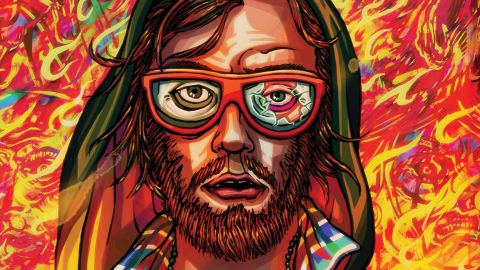GamesRadar+ Verdict
Adding good new ideas to the formula, but unable to implement them without diluting the overall experience, Hotline Miami 2 isn’t a disaster, but certainly lacks the original’s fiery vitality.
Pros
- +
Capable of the same brutally intelligent thrills as before
- +
Some of the new ideas are initially exciting
- +
The soundtrack is an absolute banger
Cons
- -
Gimmick characters dictate the gameplay too much
- -
Some new ideas fall flat
- -
It's way too long
Why you can trust GamesRadar+
Video game sequels are usually a simple undertaking, in philosophy if not execution. You take what was great about the first game, remove the bits that weren’t, push the existing gameplay mechanics in some flashy new directions, and scale the whole thing up with a shiny layer of polish.
But what if things aren’t that simple? What if your original game was fantastic precisely because it lacked the things that sequels traditionally bring? What if it was a blistering, adrenalising, punk violence masterpiece that thrived specifically because of its rough edges, singular focus, and brutally madcap nature? Then you have an interesting conundrum. And if you’re Hotline Miami 2, you have a rather irksome case of Tricky Second Album Syndrome.

Hotline Miami 2 is not a bad game. At times it’s incredible, a red-hot tornado of exhilaration, riding the knife-edge between abject terror and godlike empowerment. At times, as you drop into the stinking, neon-bleached pits of The Zone, flawlessly butchering, blasting and beating down room after room of instantly lethal, only half-predictable goons - your fingertips dancing to micromanage precision stealth, intelligent onslaught, and mutually lethal lines of sight - it’s stellar. At times, it all just comes together, the violence, the pace, the intellect, and the incendiary soundtrack blurring into one glorious, messy, indignantly ferocious whole that no other game can match. At times, as you might have gathered by now, it’s a lot like Hotline Miami.
At times.
When it isn’t doing that? It’s losing focus. It’s drifting away from the triple-distilled, acidic purity that earned the original game such a well-deserved place on our New top 100 list. It’s trying admirable new things, and sometimes succeeding, but then becoming too caught up in those Exciting Big Ideas, leaving them somewhat over-designed, lying weighty and a tad smothering on top of the intricacy of what went before. It’s not a bad game, but it’s missing something. Something raw, and free, and alive.
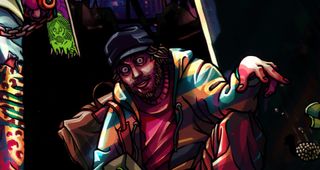
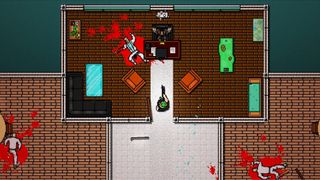
Hotline 2's soundtrack is probably the best part of the whole game. Just as good as the original's line-up of leftfield, synthy electronica, it's both more eclectic and more extreme at both ends of the spectrum. Whether delivering aggressive, scratchy dancefloor stuff or smooth, calming ambiance, it adds an immeasurable amount to the experience.
The problems stem from - or are at least facilitated by - HM2’s new narrative structure. Ostensibly set a few years after the first game (but jumping around a fair bit along the course of its deliberately disjointed delivery), you follow and play multiple different characters affected by the aftermath of original protagonist Jacket’s rampage. There’s a no-nonsense, greasy, up to his neck cop. There’s a hardboiled, fearless journalist researching his next crime book. There’s a pressured actor starring in a lurid film adaptation of the first game’s events. At the centre of it, there’s a new gang of animal-masked lunatics, influenced by Jacket, and out for a similar spree of partly purposeful kicks and killing.
Initially, this seems great. A savvy, often semi-satirical discussion and reinterpretation of the first game, using the repercussions of violence and corruption as its canvas. A smart and rather satisfying scenario, even if, as it goes on, the story seems to grow pathologically terrified of coherence, throwing in new characters, curveballs, and sub-plots whenever things seem in danger of coalescing into gratifying completion. The thing is though, those various narrative tangents bleed directly into parallel problems with the game design. And, as the game bloats on into its over-extended running time, an overall loss of focus becomes the real problem.
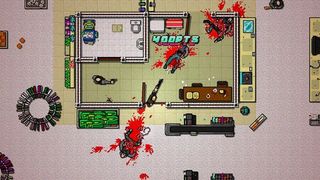
When not playing as members of the gang, things are, largely, good. The ‘normal’ protagonists play with the minimum of gimmicks, the action is as fast, flowing, but deceptively, sharply strategic as it ever was. Moment-to-moment, things feel pretty damn good, despite certain levels now seeming a little too set on providing a specific, ‘right’ solution. Contrasting the original game’s improvisational, organised chaos, Hotline 2’s missions seem to present more noticeable difficulty-gating to certain routes, with enemy placements and weapon drops sometimes even lending a vague air of Zelda-like progress. It’s only a slight change, and one that will probably be most noticeable to those who haven’t played the hell out of the original, but it does resonate with the game’s later, bigger problems. Because then the masks appear.
Picking up from the first game’s buff system, whereby wearing different, unlockable headgear would imbue Jacket with various subtle, passive abilities, such as increased speed, greater resilience, or the ability to start a level with certain weapons equipped, Hotline 2’s use of pre-masked protagonists cranks things up in both complexity and power. One Jacket fan, for instance, has an evasive roll. Another will score a kill with any object he throws. More overtly, twins Alex and Ash are controlled simultaneously, both following the same directional input while the former delivers chainsaw kills, and the latter uses pre-equipped firearms. Bear-headed Mark starts his levels with two MP5 machine pistols, which he can fire to the sides as well as dead ahead.
The first time you use any gang member, each initially delivers an exciting hook, a new spin on Hotline’s core mechanics. Some of them are thrilling for their first minute or so of use. Problem is that they’re so overt in their design and implementation that they immediately dictate your approach and flow through a level, steamrolling any other possibilities for the duration. Yes, Alex and Ash took me on a furious, pretty damn exciting spree of slaughter, once I’d nailed the strategy of target-locking long range enemies for gunshots before busting through a door to unleash blade and bullet hell. But as is so often the case with novelty gameplay, once I’d done it, I’d, well, done it.
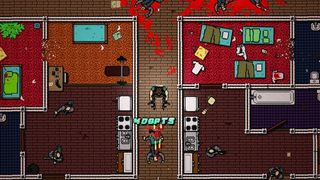
Mark amplifies the highs and lows even further, his rattling charges through his stages’ floors creating an ambivalent blend of excitement at the rampage, and irritation that you have no choice but to alert every enemy in the area with your noise. It’s doubly galling when you consider that he can’t switch to another weapon until both guns are empty, and can’t (slowly) reload until he burns off a full clip. Given Hotline 2’s staunch demands on timing, the holdover randomness of the original AI’s alert states, and the fundamental, second-to-second need to have the right tool for the job - exacerbated by the sequel’s increased placement of resilient, Heavy grunts - and you’ve got a scenario that frustrates as much as it excites. While the new mask abilities deliver a decent number of surprising, gratifying ‘Holy shit!’ moments, they also turn levels into pre-determined set-pieces, reducing nuance and burying much of the core gameplay’s intricacy.
You don’t have to use any one mask too frequently, but the fact that novelty characters keep coming back dilutes a fair amount of Hotline’s traditional appeal over the course of the whole (very long) game. And that’s before we even get into the handful of military-themed levels, whose interesting gimmick of a combined (and rigidly enforced) gun-and-knife loadout quickly falls victim to both one-note gameplay and a lunatic reliance on specific ammo crates that don’t reveal themselves until you’ve run dry. Interesting idea, employed too forcefully, and with too little finesse.

More subtly, even the ‘normal’ level design falls a little short from time to time. On a few too many occasions, the fiendish, detailed labyrinths of risk and causality give way to wide open spaces and too much encouragement to use guns. On a related note, the windowed walls that later levels of the original game used as smart, highlighted risks - allowing much greater enemy awareness than initially apparent - are utilised with impunity here, as is the decidedly blunt increase in gun-toting mooks and melee-proof specials. The problem isn’t the difficulty. Hotline has always been brilliantly, playfully hard. That’s the point. The problem is the kind of difficulty. At times, Hotline 2 exhibits a less subtle, brute force form of level design, and too often you’ll respond by drawing goons to cheap doorway ambushes rather than having fun getting out amongst it.
It’s frustrating, because the highs, when they hit, can be really high. When everything kicks in as it should, risk, reward, slaughter and strategy resonating off each other as fat, ‘80s-inspired beats burn the excitement forcibly into the sides of your head, you’ll forget the downsides and grin unashamedly, like a big, happy, murder-hyped idiot. It’s just a damn shame that those over-designed misfires keep coming back to dampen the inferno, just as the flames get tall.
This game was reviewed on PC.
More info
| Genre | Action |
| Description | An upcoming sequel for the 80's themed 2D top-down action game. |
| Platform | "Mac","PS4","PS Vita","PC" |
| US censor rating | "Mature","Mature","Mature","Mature" |
| UK censor rating | "","","","" |
| Release date | 1 January 1970 (US), 1 January 1970 (UK) |

The Stellar Blade dev team had a "competition" to see who could beat a boss first: "From that moment, all of us understood how to design the combat"

Russell Crowe is a pretend priest plagued by very real demons in the creepy first trailer for new horror movie The Exorcism

35 years after his introduction, The Simpsons just killed off a character who's been there since episode 1
